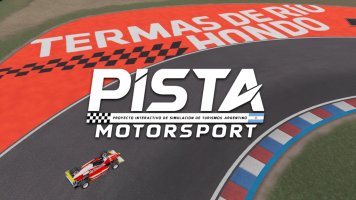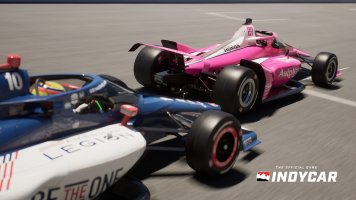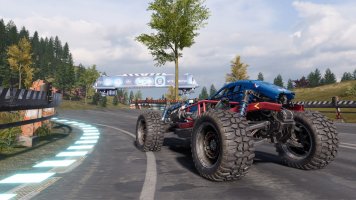You are using an out of date browser. It may not display this or other websites correctly.
You should upgrade or use an alternative browser.
You should upgrade or use an alternative browser.
The "What Are You Working On?" Thread
- Thread starter garyjpaterson
- Start date
There is a tutorial for 3ds max. But there should be something for Maya, but I think the plugin functions the same in both. It does require patience and practice beyond tutorials in order to make reliable photo matching.Do you know somebody who could explain me , the camera matching in maya ???please ^^
Yes @A3DR is probably the best I have seen at camera/photo matching it’s a real art all on its own and very frustratingThere is a tutorial for 3ds max. But there should be something for Maya, but I think the plugin functions the same in both. It does require patience and practice beyond tutorials in order to make reliable photo matching.
Do you know somebody who could explain me , the camera matching in maya ???please ^^

Camera matching is a bi*** but can be extremely helpful and worth the effort. Just wanted to start out with that. You'll find many tutorials on how to align a living room with a set of stairs or a movie scene with a door and all details on camera position and lense angle which we usually do not have.
In Maya, as in Blender, the camera settings are helpful but not really necessary. If you have the lense information (aperture, f-stop, focal length, camera type) put them in but this will matter in the final stages only. You need to think of it more as a perspective matching exercise. Camera should roughly match real life device so if you have a photo taken with a Canon 5D don't go off of an iphone sensor and vice versa.
Scene/Camera resolution need to match the photo and then you should start by moving the camera with the best guess or accurate settings to the position you think it would be when looking at the photo. The relation of focal length to distance to object is the crucial bit. Try to find distinctive reference points (edges, wheel centers, mirrors, pillars, whatever) and do a rough match then adjust focal length and distance/angle to object, after about 30 trial and error adjustments I'd stop because one thing that everyone (including @A3DR) will tell you is that you won't get a perfect match.
Line up the section/part you want to model and go from there, then move the camera to match another section and so on. I've viewed all the 3D program matching tutorials and most are useless for our purposes.
https://***********/y3eyaye5
Go over that one a few times and you'll see what I mean...could be moved to the right a bit in front but then the C pillars wouldn't match up as nice, could increase lense angle a bit to capture rear better but then front would be out of whack, wheels can't be accurate because we don't have camber in Blender, etc. etc. so you can tell...I love it!
This is the position of the camera and the Blender cam settings are set to iPhone 7, I think the picture was taken with an iPhone 5. Zooming in on specific areas, then locking the camera to view and adjusting, then doing another area and always keeping the overall match in check is the way I do it.


PS: Excuse the black triangle below the rear view mirror, that is my door panel vent mask for alignment which I forgot to hide
Last edited:
Thank you dude ,
Camera matching is a bi*** but can be extremely helpful and worth the effort. Just wanted to start out with that. You'll find many tutorials on how to align a living room with a set of stairs or a movie scene with a door and all details on camera position and lense angle which we usually do not have.
In Maya, as in Blender, the camera settings are helpful but not really necessary. If you have the lense information (aperture, f-stop, focal length, camera type) put them in but this will matter in the final stages only. You need to think of it more as a perspective matching exercise. Camera should roughly match real life device so if you have a photo taken with a Canon 5D don't go off of an iphone sensor and vice versa.
Scene/Camera resolution need to match the photo and then you should start by moving the camera with the best guess or accurate settings to the position you think it would be when looking at the photo. The relation of focal length to distance to object is the crucial bit. Try to find distinctive reference points (edges, wheel centers, mirrors, pillars, whatever) and do a rough match then adjust focal length and distance/angle to object, after about 30 trial and error adjustments I'd stop because one thing that everyone (including @A3DR) will tell you is that you won't get a perfect match.
Line up the section/part you want to model and go from there, then move the camera to match another section and so on. I've viewed all the 3D program matching tutorials and most are useless for our purposes.
https://***********/y3eyaye5
Go over that one a few times and you'll see what I mean...could be moved to the right a bit in front but then the C pillars wouldn't match up as nice, could increase lense angle a bit to capture rear better but then front would be out of whack, wheels can't be accurate because we don't have camber in Blender, etc. etc. so you can tell...I love it!
This is the position of the camera and the Blender cam settings are set to iPhone 7, I think the picture was taken with an iPhone 5. Zooming in on specific areas, then locking the camera to view and adjusting, then doing another area and always keeping the overall match in check is the way I do it.


PS: Excuse the black triangle below the rear view mirror, that is my door panel vent mask for alignment which I forgot to hide.
I was expecting a bit this kind of process yes ^^
Thank you to have make such explanation
Thank you for your time really ^^
I will definitely try out , yes
Was looking to some extra plug in , but at the end it is quite similar
As expected the pb with the knowledge of the focal , lens , is the most annoying ^^
Just in terms of how I get things lined up quickly, Blender's 3d cursor is invaluable - set it as the origin of transformations, put it on a corner of the mesh that you can see in the photo, then any rotation/scaling you do won't affect that point (changing FOV does affect it but you do less of that). Try a few places to put the cursor, usually certain rotations are easier to detect if you're moving it around the right point. eg. for rotation around Y and Z, you want something symmetric that you can see both copies of, left and right, cause once they both match, only your X rotation needs to change (and can do so without moving either copy of that point)
Great point! Just wasn't sure if Maya has the same functionality.
As for people trying to do this in Blender, it warrants mentioning always make sure you're in the right setting regarding 'lock camera to view' and actually having selected the camera as the active object when toying with the alignment .
.
Also be aware the more you manipulate the camera position around z and x the further you're actually moving the camera away from the object and eventually need to compensate with lense angle so be careful with the adjustments and keep them to a minimum.
Finally, keep in mind you have 2 settings for perspective: camera lense angle in viewport settings and focal length in camera settings!
@Stereo while I've used this approach extensively I'm not quite sure what you mean here:
As for people trying to do this in Blender, it warrants mentioning always make sure you're in the right setting regarding 'lock camera to view' and actually having selected the camera as the active object when toying with the alignment
Also be aware the more you manipulate the camera position around z and x the further you're actually moving the camera away from the object and eventually need to compensate with lense angle so be careful with the adjustments and keep them to a minimum.
Finally, keep in mind you have 2 settings for perspective: camera lense angle in viewport settings and focal length in camera settings!
@Stereo while I've used this approach extensively I'm not quite sure what you mean here:
eg. for rotation around Y and Z, you want something symmetric that you can see both copies of, left and right, cause once they both match, only your X rotation needs to change (and can do so without moving either copy of that point)

I have the mirror modifier "on cage" to help highlight what I mean - you can see that these points are in the correct spot on both sides of the grille. That means rotating the camera around the X axis wouldn't move either of them, so from here I can (e.g.) line up the edge of the windshield vertically by using that rotation.
If I do select the camera and rotate around X, the model moves like this, and you can see the X axis it's rotating around:

I think this camera's still a little long on focal length, easy way to detect that kind of thing with the model at this level of completion is if the front of the car is the right size, but the rear is too large/small. Hard to demonstrate due to the lines I'm looking at not yet existing on the model, but in this case it's marginally too large, meaning it needs a wider FOV / shorter focal length.

I have the mirror modifier "on cage" to help highlight what I mean - you can see that these points are in the correct spot on both sides of the grille. That means rotating the camera around the X axis wouldn't move either of them, so from here I can (e.g.) line up the edge of the windshield vertically by using that rotation.
If I do select the camera and rotate around X, the model moves like this, and you can see the X axis it's rotating around:

I think this camera's still a little long on focal length, easy way to detect that kind of thing with the model at this level of completion is if the front of the car is the right size, but the rear is too large/small. Hard to demonstrate due to the lines I'm looking at not yet existing on the model, but in this case it's marginally too large, meaning it needs a wider FOV / shorter focal length.
Thank you @Stereo great stuff !)
If i got it , that would be to set " the pivot " of my camera on a corner ? if I resume it quickly ?
When you start from the beginning on ??, best is to place like wheels ? because we can know the real size of it + wheel base ? then you try to place it , or an element of the environment , like houses or windows etc ?? This is where the critical point is
In this case the workshop manual has decent blueprints (just low resolution) so I modeled from that for a bit before starting photomatching. At which point I can correct the places where the manual was not drawn accurately. If I had zero orthographic reference then the wheels are easiest but it really won't start to be accurate until 2-3 photos of each part of the car are being matched. Finding long lens shots is a good option for racecars (people often shoot races with 400mm, which is close enough to orthographic to get you started if they happen to have it dead on from front/side/back)

I have the mirror modifier "on cage" to help highlight what I mean - you can see that these points are in the correct spot on both sides of the grille. That means rotating the camera around the X axis wouldn't move either of them, so from here I can (e.g.) line up the edge of the windshield vertically by using that rotation.
If I do select the camera and rotate around X, the model moves like this, and you can see the X axis it's rotating around:

I think this camera's still a little long on focal length, easy way to detect that kind of thing with the model at this level of completion is if the front of the car is the right size, but the rear is too large/small. Hard to demonstrate due to the lines I'm looking at not yet existing on the model, but in this case it's marginally too large, meaning it needs a wider FOV / shorter focal length.
Got ya, now the two angles aligned one rotating makes sense, that's exactly the way to do it.
Thank you @Stereo great stuff !)
If i got it , that would be to set " the pivot " of my camera on a corner ? if I resume it quickly ?
When you start from the beginning on ??, best is to place like wheels ? because we can know the real size of it + wheel base ? then you try to place it , or an element of the environment , like houses or windows etc ?? This is where the critical point is
Usually not a great idea to start with wheels as you'd model them in a static and symmetric way which is opposite to how they sit in real life, use the body instead. As for the pivot point you'd select your camera and then rotate/pivot it around the 3d cursor as evident in @Stereo's post.
To be clear you do not rotate the camera around it's own x-axis point of origin but instead rotate the camera around the cursor's x -axis (front grille) as the pivot point.
Fat-Alfie
Premium
At that length in the AC engine you can probably feel the car jitter through the wheelMugello circuit (61.8km)
SWEEEET!and yes, that's the Battenbergring (12.6km)
Davide Nativo
Premium
@Fat-Alfie if you could convince some modder to make an Abarth 2000 SE014 Cuneo to go alongisde your Mugello, It would be the ultra definitive combo 

EDIT wait, I know the guy! @Pessio

EDIT wait, I know the guy! @Pessio
Latest News
-
"A system for more realism, precision, fidelity and ease of use": Interview With Marble LabsMarble Labs are newcomers in the sim racing space, but the Las Vegas-based company has big...
- Yannik Haustein
- Updated:
- 5 min read
-
Ride A Rollercoaster In Assetto CorsaSome racetracks with plenty of elevation change are described as rollercoasters, but how about...
- Luca Munro
- Updated:
- 2 min read
-
2024 Formula One Canadian Grand PrixMontréal is the location for round 9 of the 2024 Formula One World Championship. The Circuit...
- Connor Minniss
- Updated:
- 4 min read
-
Test Drive Unlimited Solar Crown Demo Available On SteamAfter its release date being announced recently, Test Drive Unlimited Solar Crown is now...
- Yannik Haustein
- Updated:
- 2 min read
-
Monster Jam Showdown: "Freestyle" Trailer Shows More GameplayAnother week, another teaser trailer for Monster Jam Showdown. This time, it is all about...
- Connor Minniss
- Updated:
- 2 min read
-
Sim Racing, Friends & Fun: MOZA R3 Bundle Community Launch Event RecapFor the first time ever, the OverTake office opened its doors to the community for the MOZA R3...
- Yannik Haustein
- Updated:
- 3 min read
-
F1 24 Handling Update To Drop June 7The state of the F1 24 handling at launch was a problem for many players. EA Sports and...
- Yannik Haustein
- Updated:
- 2 min read

















